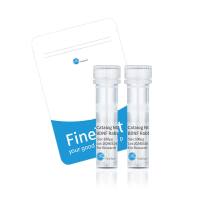PLANT DNA EXTRACTION
互联网
Meyerowitz et. al. (~1987ish)
A . thaliana has a very small haploid genome and this makes obtaining DNA somewhat difficult. The most notable problem is that DNA is usually contaminated with polysaccharide which inhibit restriction enzymes as well as other DNA modifying enzymes. This problem is most easily solved by using young plants which have not accumulated as much polysaccharide as older plants. The best results are obtained with plants that are two to three weeks post germinated.
- Harvest plants using forceps - carefully remove any adhering soil by hand.
-
Grind up the following in a mortar and pestle until no large pieces of tissue remain:
0.5 - 1.5 g plants
0.5 g of glass beads (75-150 um) per gram of plants
3 ml proteinase K buffer (0.2 M Tris (pH 8.0), 0.1 M EDTA, 1% Sarkosyl, 100 g/ml proteinase K) - Pour into 10 ml test tube. Incubate at 45-50 C for 1 hr.
- Spin 10 min at top speed in table top centrifuge (~3000 rpm)
- Decant supernatant to a fresh tube. Adjust volume to 3 ml with proteinase K buffer (with or without proteinase K).
- Add 6 ml 100% ethanol at room temperature. Invert to mix.
- Spin 10K rpm for 15 min in SS34 rotor. Discard supernatant.
- Resuspend pellet in 3 ml Tris-Cl (pH 8.0), 1 mM EDTA (TE). Vortex to resuspend.
- Extract with phenol, phenol:chloroform, chloroform.
- Add 6 ml 100% ethanol. Invert to mix.
- Spin 10K rpm for 15 min. in SS34 rotor. Discard supernatant. Air-dry pellet briefly.
- Resuspend in 4 ml TE. Vortex to resuspend.
- Add 4,5 g CsCl, 400 l 10 mg/ml ethidium bromide. Mix.
- Spin 53K rpm 16-20 hrs VTi65 20 C.
This protocol has been optimized for yield at the expense of high molecular weight DNA. The nuclear DNA can be separated from plastid DNA by running the gradients with Hoest dye, rather than ethidium bromide.







